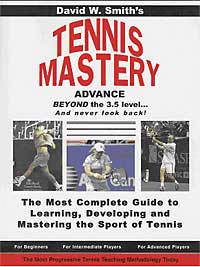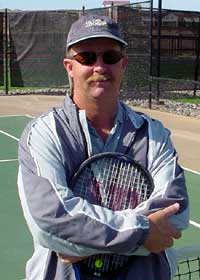|
TennisOne Lessons Extreme Makeover: The Volley David W. Smith, Senior Editor TennisOne Perhaps more than any other shot, the volley tends to either be relished or feared and avoided. The ability of players to really enjoy their volleys is directly related to two main issues: their ability to execute effective volleys and their ability to defend more difficult shots while at the net. Obviously, players who fear their own volleys won’t look to hit more effective volleys, nor will such players come to the net with a confident flair believing they will be successful in hitting volleys in particular situations.
Definitions Where many associate an effective volley as one that is hit with great pace, at higher levels, such a generality is about as far from reality as one can get. Certainly, a good poach or the closing-off of a volley at the net, especially one that is hit either as a penetrating shot or hit through a net opponent, is dependent on a firmness with relative pace. But even with this being said, the majority of skilled players rely far more on directional control, angles, touch, and spin to execute successful volleys. Most volleys in the mid court area are not likely to be hit as winners. These “transition” volleys are hit to gain an advantage based on the position of the ball, court, themselves, and where the volley will place the opponent. Mid court volleys are usually hit with a solid, but controlling stroke, with the most effective transition volley usually hit deep near the baseline against back court opponents, or at the feet of opponents who follow their own shots to the net. I often see players trying to bust a first volley, only to find their opponents using that pace to block the volley into the open court. Fact is, unless a player is very close to the net, at higher levels, many hard volleys are just not that difficult to simply block back. Also, a harder volley leaves less time for recovery and the harder swing tends to throw the vollyer off balance, which may result in an error or, at the very least, again making recovery more difficult.
Nearly all pros, college players, top juniors and good club players use the continental grip as their “foundation” grip for volleys. These more advanced or skilled net players use angles and touch a lot more than intermediate players. The successful execution of an angle or touch volley is dependant on proper technique. Players who use inferior or “limiting” grips on the volley, (usually eastern forehand and backhand), simply can’t execute angles and touch with any kind of consistency like those players who use the continental grip. The bottom line is that there are severe limitations placed on the beginning and intermediate players when first introduced to eastern grips for volleys. There may be some rare exceptions, but generally, players who use eastern grips on their volleys seldom are able to master all the elements and effectiveness that is possible when using the more advanced continental grip as their foundation grip. Making Over Your Volley Obviously, the foundation of virtually any stroke begins with the grip. 99% of all prominent tennis books and DVD’s recommend the continental grip for more advanced volley progressions. If one is just starting out, it is incredibly important to establish this grip’s comfort and familiarity because the continental grip is also the foundation grip for the serve, overhead, slice backhand, and two-handed backhand, (dominant hand for the majority of skilled two-handers)!
There are many drills to help facilitate the familiarity and comfort of the continental grip. Since the grip is usually unfamiliar to most beginners—and certainly to those who first learned using eastern grips—it is important to train the hand to feel comfortable and familiar with the continental grip. Some of the best drills I use for training players have been outlined in an article I did called, “Rounding Out Drills, Part I” found here at TennisOne. In addition to these volley drills and exercises, some very simple drills include up bounces, (holding the continental grip in a palm down position and bouncing balls up on the “backhand side” of the racquet) and down bounces, (kneeling down, holding the continental grip and bouncing the ball on the ground on the “forehand side” of the racquet). One important exercise and practice is to work on what I call “Toss and Block” drills. These drills can be done anywhere since they don’t need the use of a net to execute. Toss and Block drills allow a player with a partner to focus completely on the technique instead of trying to hit a ball to a target over a net and deep in the court. While the ability to aim and gain control of the volley using targets and depth is absolutely important, the problem is that many players, especially those trying to establish new form, will revert back to old habits and grips when put into a situation that simulates a game-like scenario. Instead, Toss and Block drills allow repetition and focus on the grip and the stroke component instead of a goal of hitting the ball to a target. Once the desired volley pattern and grip is established, then moving to “on-court” drills is advisable. Form and Function A change in grip will change many aspects of the volley and those who have been using eastern grips will find extreme difficulty in directing balls when they move to the continental grip. Players who use eastern grips tend to face the net and establish a racquet position that is nearly perpendicular to their forearm. If you look at the contact point of most pros, you will see that the racquet is nearly parallel with the forearm. In addition, the contact point is seldom way out in front of the player towards the target; instead, the contact point is usually parallel with the player’s front knee (provided they have stepped into the ball across their body). This position of the racquet is still “out in front” of the player, but not towards the target, rather it is sideways perpendicular to the target. Using the continental grip, the “unit turn” on the volley sets the racquet square to the incoming ball.
The problem with players using the eastern grips is that the moment the player turns sideways, the racquet ends up being taken back well beyond the optimal contact point needed for a clean volley. This is the main reason players who use eastern grips can’t hit significant angles or touch: when a player takes the racquet back past the proper contact point, (for a particular angle or target), he must swing the racquet to reestablish this optimal angle. This swing creates far too much racquet-head speed to hit any touch, angle, or finesse volley. When I teach a clinic and we work on sharp angle volleys, those who use the eastern grips almost never hit balls at the desired angle. They usually hit the ball too deep, or, when they do try to hit the correct angle, they hit the ball way too hard for any opportunity for success. This limits their options considerably. One of the biggest problems with the eastern grip is the pattern of trying to shift from forehand to backhand. While there are a small number of pros who would suggest there is time to change grips, at higher levels, this is simply not true. One pro suggests that if we have time to change grips while receiving 130 mph serves, we should have ample time to change grips while at the net, however, this logic is faulty. A serve decreases its speed considerably while traveling the distance from baseline to baseline, especially after the bounce in the service box. The reduction of speed, in addition to the added visual distance a player has to identify the serve, is considerably different than a player standing approximately half the distance (while at the net), and attempting to read and hit a ball that is decreasing in speed only an insignificant amount between the strike and the arrival time at the net.
This issue is further compounded when two or more players are at the net in a reflex volley situation. A ball traveling from a much shorter distance, even at a significantly slower speed, offers exponentially less time to react and respond correctly. The need to change grips within such situations makes players struggle to advance their play at the net. In addition, the infamous “windshield wiper move,” where a player holds an eastern forehand grip for a forehand and simply rotates the racquet over their head to hit a backhand striking the ball on the same side of the racquet, is prevalent among the players using eastern grips on their volleys. While players can actually get away with this rudimentary pattern at lower levels, at higher levels, where opponents come to the net more frequently, and balls are hit with more speed, more spin, and at lower trajectories, this technique will indeed hinder improvement and stagnate them at lower levels. Backhand Volley When using the correct grip, the volley becomes relatively simple. In fact, most breakdowns in the volley occur because players employ more movements than needed. With the backhand volley, there are important Key Position Points that players need to identify and emulate. These are:
Forehand Volley Nearly all the components of the backhand volley follow the same generalities associated with the forehand volley. There are three notable exceptions:
Other components of the forehand volley include:
If you review the hundreds of video clips of the pros hitting a wide variety of volleys, you will find these key position points and generalities among all them. While there will be exceptions, the general foundation of their volleys will correlate with those described here. Perhaps most importantly, a player who uses the form prescribed here will not fall victim to the common faults and failures so many millions of players encounter when they learn the volley in an inferior manner. And players who do have suspect volleys will be able to identify their faults if they look at their volleys in comparison to the check-list of key points listed here. Conclusion Become the volley player you know you can be! It will take time for these patterns to become familiar and comfortable. It will also take many attempts in competition to learn to execute these shots successfully and consistently. Too often players will learn something new, go out the next day and try it in a match, only to aim wrong, miss-time the shot, make a mistake in execution, and think, “hey, this isn’t working,” then abandon the proper technique and revert back to their old, comfortable but limiting volley patterns. Ironically, those same players are more than happy to miss a shot using their comfortable patterns! But, when they miss with something new, something that isn’t familiar, they quickly abandon the new pattern and fall back on the old, inferior technique. The result is that they relegate themselves to comfortable but lower levels of play. Yet, if they would spend the time and energy on developing these more advanced volley techniques, a whole new world of skilled tennis might open up to them! (Click link to purchase Dave Smith's newest Book Coaching Mastery, at tenniswarehouse.com or go to www.coaching-mastery.com for more information and order a personalized autographed copy direct from the author. Your comments are welcome. Let us know what you think about Dave Smith's article by emailing us here at TennisOne .
|

 Your comments are welcome. Let us know what you think about this article by
Your comments are welcome. Let us know what you think about this article by